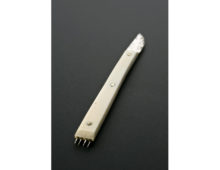Tagged with War and Warfare
Resource : “Waterloo Teeth”
This set of dentures is fitted with real human teeth, extracted from the mouths of dead soldiers.
Resource : Prosthetic leg of Earl of Uxbridge
This is one of three prosthetic legs made for Henry Paget, Earl of Uxbridge, who commanded the British cavalry at the Battle of Waterloo.
Resource : Napoleon’s Hat
This hat was worn by the French Emperor Napoleon when he commanded the French Army at the Battle of Waterloo. The hat was a vital part of the image of a hard-working, down-to-earth leader that Napoleon tried to create. His profile was instantly recognisable to French soldiers, most of whom were devoted to him. The red, white and blue cockade, pinned to the hat, is a symbol of the French Revolution.
Resource : Túpac Amaru II
Túpac Amaru II was the leader of the largest uprising in colonial Spanish-American history which raged across the Andes from 1780-1783. It became more violent as it progressed, and also more radical, more antislavery, and more anti-Hispanic. Its leader is still remembered in Peru and Bolivia and beyond today.
Resource : The Battle of Vinegar Hill (1798)
The uprising in Ireland, in 1798, was a major rebellion against colonial British rule. It was led by the United Irishmen – a mixed group of Protestant and Catholic radicals. The Battle of Vinegar Hill, as it became known, in County Wexford in the southeast of Ireland, was the last major engagement between the United Irishmen and the British military and marked a significant turning point in the rebellion.
Resource : Waterloo Descendants Book addition offers link to American Industrial Revolution
August 27, 2019 - Richard Moss
A new upload to the Waterloo Descendants Book uncovers the story of a Waterloo veteran with a family link to the American Industrial Revolution Waterloo 200 launched the Waterloo Descendants Book with the online Book Company in 2015 to feature the untold stories of the soldiers who fought at the Battle of Waterloo. Descendants and […]
Resource : Theobald Wolfe Tone
Wolfe Tone was a founder of the United Irishmen and a leading figure in the fight for Irish independence from British rule. In 1798, Tone led the United Irishmen in a major uprising, hoping to begin a nationalist and republican revolution in Ireland with the support of French troops.
Resource : The Plumb-Pudding in Danger
This print was one of over a thousand satires produced by the celebrated caricaturist, James Gillray, who became known as the ‘father of the political cartoon’. In the 18th century, cartoons and caricatures were a popular way of mocking the establishment and calling them to account. They would be discussed and enjoyed in shop windows, coffee houses and taverns. The arrival of the industrial printing press in the 1800s helped to spread them far and wide, through broadsides (posters), newspapers and pamphlets. This one was inspired by the resumed hostilities and ongoing rivalry between Britain and France in 1805.
Resource : Sir Joshua Reynolds’ portrait of Sir Banestre Tarleton
This portrait shows the flamboyant and controversial figure Sir Banestre Tarleton, a cavalry officer best known as commander of the ‘Tarleton Raiders’ during the American war of independence. It was painted by Sir Joshua Reynolds, the leading British portrait painter of the 18th century. Reynolds was a founding member of the Royal Academy and its first President, and was knighted by King George III.
Resource : Bone ship model
During the Revolutionary and Napoleonic wars, prisoner exchanges between Britain and France only occurred rarely, meaning large numbers of captives were held for long periods in each country. French prisoners in Britain were often invited or compelled to practice crafts, and manufactured many intricate models made from bones and other recycled goods.


